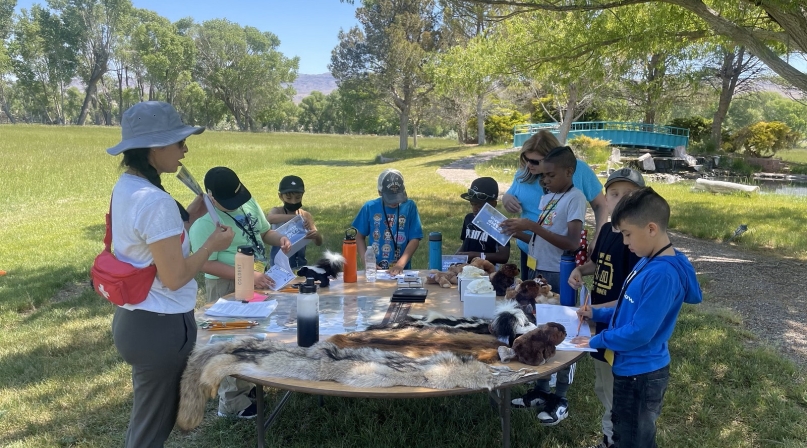Two-county solution offers urban Nevada kids a rural retreat

Key Takeaways
Marilyn Kirkpatrick had an out-of-the-box solution for her district’s parks problem that will, in turn, let hundreds of urban Clark County, Nev. kids out of a box of their own.
With millions of dollars in tax revenue built up to create a new park, specifically a 4-H camp, the world would seem to be Commissioner Kirkpatrick’s oyster. But much like oysters, available land surrounding Las Vegas is in short supply, dramatically limited by federally owned land throughout the county — the norm for the state. Over three years, the largest plot she could find for the camp was 10 acres. She and Varlin Higbee, a commissioner in neighboring Lincoln County, hatched a plan.
“I called Varlin and said, ‘If I give you $5 million, will you buy a camp for me?’” she said.
He and the Lincoln County University of Nevada, Reno Extension Office had a place in mind — a corporate events center in Higbee’s hometown of Alamo that was on sale after declining use since the COVID-19 pandemic. It meant a lot to Higbee to see it find a renewed purpose, and one close to his heart. One that inspires him to add his efforts, partially out of muscle memory, to make the camp a success.
“I need to get out and cut that hay,” he said looking out from the porch of the events center in May 2023, the last day of operations for the JFDI Ranch before it changed hands. “That was alfalfa over there when I was a kid — we could grow alfalfa like you wouldn’t believe. We leased this from my cousin on my dad’s side. I remember cutting this back then.
“Yeah, it’s a little different out here.”
That’s what Higbee and Kirkpatrick are aiming for — giving a new experience to children who don’t usually get to leave their urban neighborhoods. An hour and 15 minutes on a bus can change their perspectives and blow their minds, and that’s before they even arrive at the 72-acre camp and see the 17-bedroom, 17,000 square-foot building that may soon support overnight trips that can give kids their first view of a full night sky. The route to Alamo passes through the habitat for hundreds of species of birds, petroglyphs and a gypsum mine.
“I don’t know how many of them have seen a pond before,” Higbee said.
Day trips have been going on all summer, and Don Deever, Lincoln County’s Extension educator, has noticed the effect the place has on the 2,000 kids who have visited so far.
“The kids turn in their phones when they arrive, so they are immersed in the natural world,” Deever said. “What blew me away was that these kids got it — they knew what we were trying to do and they didn’t put up a fight. They’ve never known a world like this, and they totally get why this is special.”
It has already passed muster with Kirkpatrick’s grandchildren.
“They tell me that Alamo has the biggest and best insects,” she said.
Deever has lent his botanical knowledge to a lot of programming, but when the camp is fully engaged, the better-staffed Clark County office will provide more support. Lincoln County’s entire staff includes just Deever and a part-time colleague.
The union will also reflect Clark and Lincoln’s history when both were Lincoln County. Since they split in 1909, Clark is now the 11th largest U.S county and Lincoln County is so sparsely populated that the Census Bureau classifies it as “frontier.”
“This is helping to heal the divide between urban and rural counties, just by exposing urban kids to rural life,” Kirkpatrick said.

The Nevada Three-Step
What started as a complication — Clark County’s inability to own land in another county — ended up building a complex but beneficial arrangement.
“Initially, Lincoln County didn’t want to own it, because of the liability involved,” Kirkpatrick said. “We did the due diligence and figured out what maintenance costs would total over eight years and what the property tax revenue would be if a private entity owned it and figured that all into the lease. Lincoln County will actually make money off of it.”
A pair of memoranda of understanding will allow Clark County to use the camp for one-third of the year, while a three-way agreement between the counties and the university would force the counties to turn their keys in at the same time if the university wanted to end the agreement.
“Everyone has skin in the game, that’s why it will work,” Kirkpatrick said.
When Clark County isn’t using the camp, Lincoln County is free to book its own events, including continuing a relationship with its former owner.
Like miners digging different directions about to converge on a lode of diamonds, Deever had been working the same problem as Kirkpatrick, and his prep work helped expedite the deal. With the state’s other 4-H camp more than seven hours away at Lake Tahoe, he was looking for an option in Southern Nevada.
While he originally eyed a location in northern Lincoln County, the ready-made situation in Alamo was too good to pass up and was more geographically aligned with the state’s population center. And it will benefit the county beyond the revenue for the camp.
“Lincoln County is a place with the highest unemployment and the lowest wage,” Deever said. “If you have something that comes in and creates just one new job, that’s big news. this camp has created two jobs so far — a manager and a sales person — and we’ll need a caretaker and a cook, so that’s four jobs. It’s huge.”
Higbee said the nature of the jobs, mostly part-time, will appeal to local residents who want to supplement their income.
He’s excited about some of the activity options that will be available when the camp is fully operational — a rifle range, an archery range, a climbing wall and a new high ropes course. His main regret is that the property’s prominent pond is for the building’s fire suppression system and won’t accommodate swimming or boating.
“Remote control boats are fine,” he said. “We’re hoping to use the facility for robotics competitions.”
It’s part of what Kirkpatrick says will be an effort to modernize 4-H for her constituents.
“The mission of 4-H needs to pivot sometimes to reflect the needs of our kids,” she said. “Agriculture is definitely something Clark County kids can learn about, but there are some tracks they could benefit from, like learning about Mexican culture and traditions, because it’s such a prominent part of our community. If we can hold a state robotics competition here, that will really show the range of what this place can be for kids. Outdoors or high tech.”
Part of the buildout includes additional bunk rooms, expanding on the camp’s 50-person overnight capacity, with additional investment in equipment from Clark County.
“Part of me wishes I could have found somewhere in Clark County for this, but it’s better this way,” Kirkpatrick said. “This is teaching our students so much more about the rest of Nevada and offering them an experience they’ll remember forever.”
Related News

County Countdown – Dec. 15, 2025
Every other week, NACo's County Countdown reviews top federal policy advocacy items with an eye towards counties and the intergovernmental partnership.
Stretching small opioid settlement allocations helps funding do more
States and localities are set to receive $56 billion in opioid settlement dollars over an 18-year period, but not every county that receives settlement funding will get enough to build out infrastructure.
Telling the County Story
Counties Work Game & Curriculum
Counties Work is an online game and curriculum to educate students about the important role and functions of county government.


